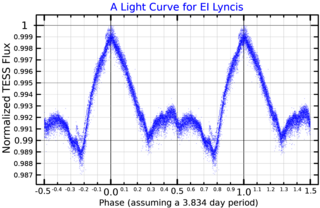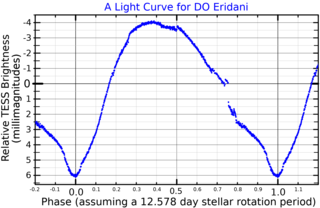
12 Canis Majoris is a variable star located about 707 light years away from the Sun in the southern constellation of Canis Major. It has the variable star designation HK Canis Majoris; 12 Canis Majoris is the Flamsteed designation. This body is just barely visible to the naked eye as a dim, blue-white hued star with a baseline apparent visual magnitude of +6.07. It is moving away from the Earth with a heliocentric radial velocity of +16 km/s. This is the brightest star in the vicinity of the open cluster NGC 2287, although it is probably not a member based on its proper motion.
21 Canum Venaticorum is a single variable star in the northern constellation of Canes Venatici, located 277 light years away from the Sun. This object has the variable star designation BK Canum Venaticorum; 21 Canum Venaticorum is the Flamsteed designation. It is visible to the naked eye as a faint white-hued star with a baseline apparent visual magnitude of +5.14.

HD 125823, also known as V761 Centauri or a Centauri, is a variable star in the constellation Centaurus. It is a blue-white star that is visible to the naked eye with a mean apparent visual magnitude of +4.41. The distance to this star is approximately 460 light years based on parallax measurements. It is a member of the Upper Centaurus–Lupus subgroup of the Scorpius–Centaurus association.

HD 37017 is a binary star system in the equatorial constellation of Orion. It has the variable star designation V1046 Orionis; HD 37017 is the identifier from the Henry Draper Catalogue. The system is a challenge to view with the naked eye, being close to the lower limit of visibility with a combined apparent visual magnitude of 6.55. It is located at a distance of approximately 1,230 light years based on parallax, and is drifting further away with a radial velocity of +32 km/s. The system is part of star cluster NGC 1981.
HD 1606 is a single star in the northern constellation of Andromeda, positioned a few degrees to the northeast of the bright star Alpheratz. It has a blue-white hue and is dimly visible to the naked eye with an apparent visual magnitude of 5.87. Although it is suspected of variability, none has been conclusively found. The star is located at a distance of approximately 580 light-years from the Sun based on parallax, and is drifting further away with a radial velocity of +4 km/s. It has an absolute magnitude of −0.5.

V518 Carinae is a naked-eye variable star in the constellation Carina. It is a member of the bright open cluster IC 2602 near the Carina Nebula.

HD 137509 is a star in the southern constellation of Apus, positioned less than a degree from the northern constellation boundary with Triangulum Australe. It has the variable star designation of NN Apodis, or NN Aps for short, and ranges in brightness from an apparent visual magnitude of 6.86 down to 6.93 with a period of 4.4916 days. The star is located at a distance of approximately 647 light years from the Sun based on parallax, and is drifting further away with a radial velocity of +0.50 km/s.

36 Lyncis is a solitary variable star located around 620 light years away from the Sun in the northern constellation of Lynx. It has the variable star designation of EI Lyncis, while 36 Lyncis is the Flamsteed designation. This object is visible to the naked eye as a dim, blue-white hued star with an apparent visual magnitude of 5.30. It is moving further away from the Earth with a heliocentric radial velocity of 21 km/s.

V915 Scorpii is an orange hypergiant variable star in the constellation Scorpius.
Helium-weak stars are chemically peculiar stars which have a weak helium lines for their spectral type. Their helium lines place them in a later spectral type then their hydrogen lines.

KQ Velorum is a variable star system in the southern constellation of Vela. It has the identifier HD 94660 in the Henry Draper Catalogue; KQ Vel is the variable star designation. This appears as a sixth magnitude star with an apparent visual magnitude of 6.112, and thus is dimly visible to the naked eye under suitable viewing conditions. The system is located at a distance of approximately 373 light years from the Sun based on parallax measurements, and is drifting further away with a radial velocity of around 23 km/s.

17 Comae Berenices is a multiple star system in the northern constellation of Coma Berenices. The brighter component, 17 Com A, is a naked eye star with an apparent visual magnitude of 5.2. It has a faint companion of magnitude 6.6, 17 Com B, positioned at an angular separation of 146.4″ along a position angle of 251°, as of 2018. They are located at a distance of approximately 240 light years from the Sun based on parallax measurements.
KS Persei is a binary system in the equatorial constellation of Perseus. It is sometimes known as Bidelman's Star, named after William P. Bidelman. The star is invisible to the naked eye with a mean apparent visual magnitude of 7.70. As of 2018, the structure and evolutionary history of this system remain uncertain, although some form of mass transfer is likely to have occurred to explain the observed properties.

HD 44506 is a solitary, blue hued star located in the southern constellation Columba. The object is also called HR 2288, which is its Bright Star Catalog designation. It has an average apparent magnitude of 5.52, making it faintly visible to the naked eye under ideal conditions. HD 44506 is located relatively far at a distance of 1,800 light years based on Gaia DR3 parallax measurements but is receding with a heliocentric radial velocity of 54 km/s.

HR 1217 is a variable star in the constellation Eridanus. It has the variable star designation DO Eridani, but this seldom appears in the astronomical literature; it is usually called either HR 1217 or HD 24712. At its brightest, HR 1217 has an apparent magnitude of 5.97, making it very faintly visible to the naked eye for an observer with excellent dark-sky conditions.

HD 142990, also known as HR 5942 and V913 Scorpii, is a star about 470 light years from the Earth, in the constellation Scorpius. It is a 5th magnitude star, so it will be faintly visible to the naked eye of an observer far from city lights. It is a variable star, whose brightness varies slightly from 5.40 to 5.47 during its 23.5 hour rotation period. It is a member of the Upper Scorpius Region of the Scorpius–Centaurus association.

HD 21699, also known as HR 1063 and V396 Persei, is a star about 580 light years from the Earth, in the constellation Perseus. It is a 5th magnitude star, so it will be faintly visible to the naked eye of an observer far from city lights. It is a variable star, whose brightness varies slightly from 5.45 to 5.53 during its 2.4761 day rotation period. It has a remarkable dipole magnetic field which is displaced from the star's center by 0.4 stellar radii, the poles of which appear close to each other on the stellar surface. HD 21699 is a member of the Alpha Persei Cluster.

V686 Coronae Australis is a solitary, bluish-white-hued variable star located in the southern constellation Corona Australis. It has an apparent magnitude that ranges between 5.25 and 5.41, which makes it faintly visible to the naked eye. Gaia DR3 parallax measurements imply a distance of 480 light years and it is slowly receding with a heliocentric radial velocity of 1.3 km/s. At its current distance V686 CrA's average brightness is diminished by 0.35 magnitudes due to extinction from interstellar dust and it has an absolute visual magnitude of −0.24.

HD 187474, also known as HR 7552 and V3961 Sagittarii, is a star about 315 light years from the Earth, in the constellation Sagittarius. It is a 5th magnitude star, so it will be faintly visible to the naked eye of an observer far from city lights. It is a variable star, whose brightness varies slightly from magnitude 5.28 to 5.34. HD 187474 is classified as an Alpha2 Canum Venaticorum variable star, but it has a rotation period of 2345 days - more than an order of magnitude longer than is typical for that class. HD 187474 is an Ap star.

HD 27563, also known by the Bayer designation d Eridani, is a single star in Eridanus, in the direction of the Orion–Eridanus Superbubble, that is faintly visible to the naked eye at a magnitude of about 5.84. Cowley (1972) classifies this star as spectral type B5III, but Houk and Swift (1999) catalog it as B7II.

















